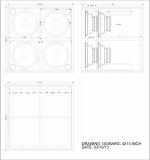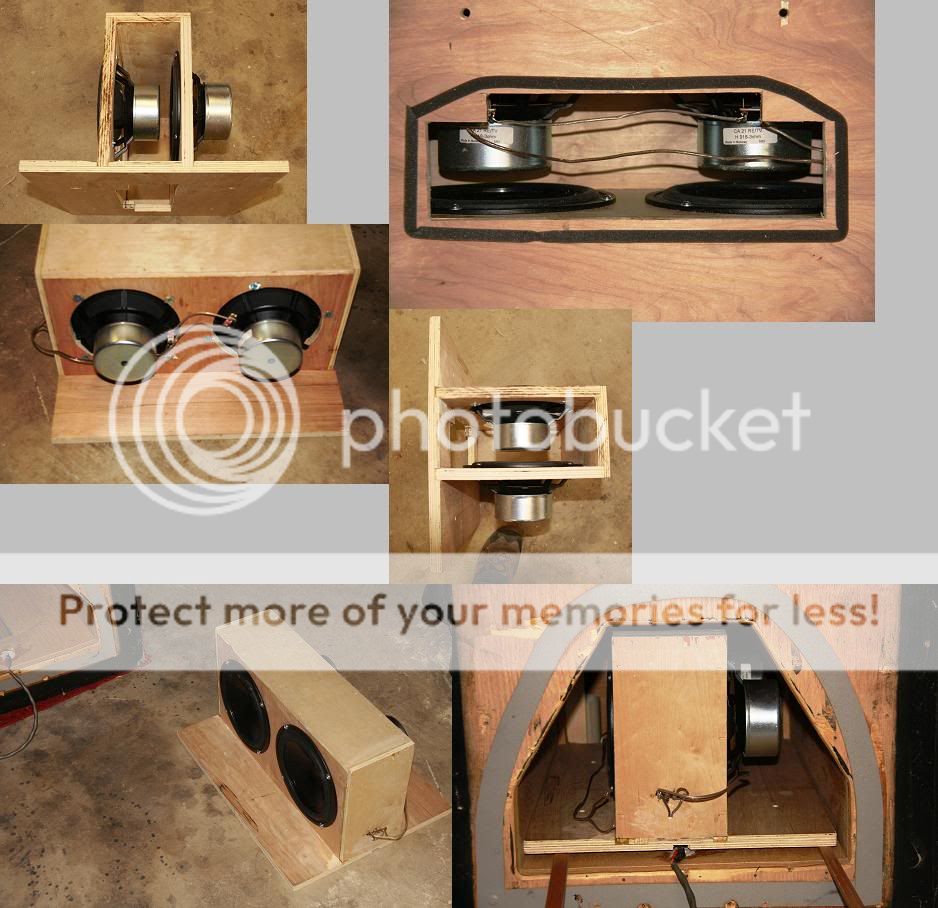I was recently given 8 - 10" Bugera drivers with aluminum cones. Rated @ 240 watts each. I've never tried an Isobaric cabinet before. Designed and built lots of P.A. speakers and all have worked very well. Thought I'd put this design up and see if there were any opinions. 3/4" ply with 4-2" vents 18" long and insulation dampening. Some details left off plan for clarity.
Thank you for your consideration!
Thank you for your consideration!
Attachments
If the drivers are not back vented, or the vents do not make noise, I would suggest mounting the drivers cone to cone, reversing the polarity of the drivers with the magnets out.I was recently given 8 - 10" Bugera drivers with aluminum cones. Rated @ 240 watts each. I've never tried an Isobaric cabinet before. Designed and built lots of P.A. speakers and all have worked very well. Thought I'd put this design up and see if there were any opinions. 3/4" ply with 4-2" vents 18" long and insulation dampening. Some details left off plan for clarity.
Thank you for your consideration!
Simplifies construction, reduces even order harmonic distortion, and the reduced enclosed area makes the output sound "tighter".
Precicely. That's what I want to know. What do I gain from going isobaric. A friend told me about them. Then I got the free drivers and I'm always building something. Usaully bass bins. I could always use any of those types of bin. Bass cab or sub. Just experimenting really. Have got lots of power to try with them. Just thought I'd put the design out here first to get some feed back from people such as yourself.  )
)
@ Smeneice
Half the volume required of the box.
What do I gain from going isobaric.
Half the volume required of the box.
Right, box size can be half for a given low frequency cutoff, while using double the drivers and power for roughly the same output as a single driver in a larger box.@ Smeneice
Half the volume required of the box.
I can't say I see any reason to do isobaric.
If you mount the same number or drivers in the same size vented box you will get 6dB more output an octave above Fb. The output a half-octave above Fb will be equal, and at F3 it will have about 3dB less output than isobaric.
The simulation I used had a pair of 15s in 5.627 cu ft tuned to 22hz. Both designs had equal output at 31hz, the non-isobaric had 3dB more output at 40hz, and 6dB more output at 55hz and above. 55hz is the peak output frequency in typical dance music.
I would rather have the same size box and the extra output available with non-isobaric.
If you mount the same number or drivers in the same size vented box you will get 6dB more output an octave above Fb. The output a half-octave above Fb will be equal, and at F3 it will have about 3dB less output than isobaric.
The simulation I used had a pair of 15s in 5.627 cu ft tuned to 22hz. Both designs had equal output at 31hz, the non-isobaric had 3dB more output at 40hz, and 6dB more output at 55hz and above. 55hz is the peak output frequency in typical dance music.
I would rather have the same size box and the extra output available with non-isobaric.
Thank you for this. That's very interesting. I'm starting to think that isobaric designs should only be used when absolutely nessasary. Vented flush mount is my usual build. They all seem to do well.
When you say "The same number of drivers in the same size box" I assume you mean the four drivers on the face plate. I could build two such cabs, non isobaric. You can imagine having eight drivers just sitting on the shelf makes you want to do something with them. Thought I'd get creative. Perhaps I'll come up with something else. Thanks again DJK for the info!
When you say "The same number of drivers in the same size box" I assume you mean the four drivers on the face plate. I could build two such cabs, non isobaric. You can imagine having eight drivers just sitting on the shelf makes you want to do something with them. Thought I'd get creative. Perhaps I'll come up with something else. Thanks again DJK for the info!
if you are looking for an experiment and have the drivers I would highly recommend trying a passive radiator.
with isobaric you mainly gain 1/2 vas. however at the cost of efficiency.
with a passive radiator you have soo many options to get creative. such a single/dual reflex. an awesome design is a fourth order bandpass with a pr. --- would be intense
with isobaric you mainly gain 1/2 vas. however at the cost of efficiency.
with a passive radiator you have soo many options to get creative. such a single/dual reflex. an awesome design is a fourth order bandpass with a pr. --- would be intense
If the drivers are not back vented, or the vents do not make noise, I would suggest mounting the drivers cone to cone, reversing the polarity of the drivers with the magnets out.
Simplifies construction, reduces even order harmonic distortion, and the reduced enclosed area makes the output sound "tighter".
I second that, especially for ported (vented / reflex) type enclosures. You need to minimise the volume between the driver cones. I've posted a graph elsewhere on diyaudio to show this:
http://www.diyaudio.com/forums/subwoofers/229628-isobaric-tapped-horns.html#post3362557
It shows the differences in excursion between the two drivers of an isobaric pair in a tapped horn design. The same thing happens in a ported enclosure at the enclosure resonant frequency. It's less of an issue in sealed enclosures.
- Status
- This old topic is closed. If you want to reopen this topic, contact a moderator using the "Report Post" button.
- Home
- Loudspeakers
- Subwoofers
- Submitted for your approval, Isobaric cab.

